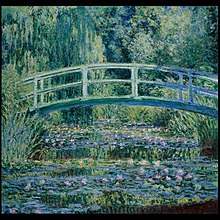Lahabali kɔligu:Water-Lilies-and-Japanese-Bridge-(1897-1899)-Monet.jpg

Jɔhiyuli maa galisim:617 × 599 anfooni bihi bihi. Din pahi resolutions: 247 × 240 anfooni bihi bihi | 494 × 480 anfooni bihi bihi | 791 × 768 anfooni bihi bihi | 1,031 × 1,001 anfooni bihi bihi.
Faal maa maŋmaŋa (1,031 × 1,001 pixels, file size: 381 KB, MIME type: image/jpeg)
Faal tarihi
Dihimi dabisili/saha n-nya kɔl' bihi kamani di ni di yina shɛm
| Zuŋɔ dabisili/Saha | Thumbnail | Di tarisi | ŋun su | tɔhibu | |
|---|---|---|---|---|---|
| din na chana | 20:57, 19 Silimin gɔli January 2009 |  | 1,031 × 1,001 (381 KB) | Krscal | {{Information |Description={{en|1=Water Lilies and Japanese Bridge (1897-1899) by Claude Monet Princeton University Art Museum}} |Source=the-athenaeum.org http://www.the-athenaeum.org/art/full.php?ID=3788 |Author=Claude Monet |Date=1897-1899 |Permission= |
Lahibali kɔligu zaŋ tum tuma
Din doli ŋɔ na yaɣili tuma nima zaŋ ti lahabali kɔligu ŋɔ:
Duniya zaa lahabali kɔligu zaŋ tum tuma
Wikis shɛŋa ŋan dolina ŋɔ gba malila faal ŋɔ n kuri bukaata:
- Zaŋ tum tuma en.wikipedia.org zuɣuc
- Zaŋ tum tuma en.wikivoyage.org zuɣuc
- Zaŋ tum tuma et.wikipedia.org zuɣuc
- Zaŋ tum tuma fr.wikivoyage.org zuɣuc
- Zaŋ tum tuma ja.wikipedia.org zuɣuc
- Zaŋ tum tuma kbp.wikipedia.org zuɣuc
- Zaŋ tum tuma lv.wikipedia.org zuɣuc
- Zaŋ tum tuma pl.wikipedia.org zuɣuc
- Zaŋ tum tuma pt.wikipedia.org zuɣuc
- Zaŋ tum tuma ro.wikipedia.org zuɣuc
- Zaŋ tum tuma sl.wikipedia.org zuɣuc
- Zaŋ tum tuma sq.wikipedia.org zuɣuc
- Zaŋ tum tuma sv.wikipedia.org zuɣuc
- Zaŋ tum tuma ta.wikipedia.org zuɣuc
- Zaŋ tum tuma vi.wikipedia.org zuɣuc



